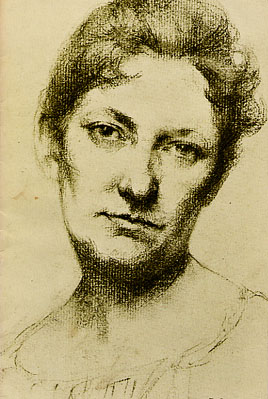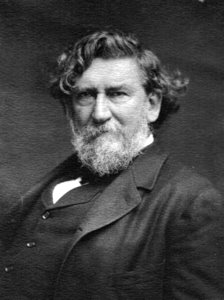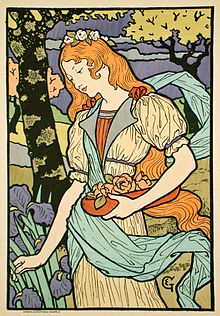
John Maler Collier was a British painter and writer. He painted in the Pre-Raphaelite style, and was one of the most prominent portrait painters of his generation. Both of his marriages were to daughters of Thomas Henry Huxley. He was educated at Eton College, and he studied painting in Paris with Jean-Paul Laurens and at the Munich Academy starting in 1875.

Sophia Theresa "Sophie" Pemberton was a Canadian painter who was British Columbia's first professional woman artist. Despite the social limitations placed on female artists at the time, she made a noteworthy contribution to Canadian art and, in 1899, was the first woman to win the Prix Julian from the Académie Julian for portraiture. Pemberton also was the first artist from British Columbia to receive international acclaim when her work was exhibited at the Royal Academy in London (1897).

Frank Weston Benson, frequently referred to as Frank W. Benson, was an American artist from Salem, Massachusetts, known for his Realistic portraits, American Impressionist paintings, watercolors and etchings. He began his career painting portraits of distinguished families and murals for the Library of Congress. Some of his best known paintings depict his daughters outdoors at Benson's summer home, Wooster Farm, on the island of North Haven, Maine. He also produced numerous oil, wash and watercolor paintings and etchings of wildfowl and landscapes.
Events from the year 1905 in art.

Minerva Josephine Chapman (1858–1947) was an American painter. She was known for her work in miniature portraiture, landscape, and still life.
The Royal Society of Miniature Painters, Sculptors and Gravers, more commonly known as the Royal Miniature Society (RMS), is an art society founded in 1895 dedicated to upholding and continuing the tradition of miniature painting and sculpture, generally meaning the painted portrait miniature, a particular English tradition.

Thomas Satterwhite Noble was an American painter as well as the first head of the McMicken School of Design in Cincinnati, Ohio.

Adolfo Müller-Ury, KSG was a Swiss-born American portrait painter and impressionistic painter of roses and still life.

Emma Lampert Cooper was a painter from Rochester, New York, described as "a painter of exceptional ability". She studied in Rochester, New York; New York City under William Merritt Chase, Paris at the Académie Delécluse and in the Netherlands under Hein Kever. Cooper won awards at several World's Expositions, taught art and was an art director. She met her husband, Colin Campbell Cooper in the Netherlands and the two traveled, painted and exhibited their works together.

Ethel Carrick, later Ethel Carrick Fox was an English Impressionist and Post-Impressionist painter. Much of her career was spent in France and in Australia, where she was associated with the movement known as the Heidelberg School.

Grundmann Studios (1893–1917) in Boston, Massachusetts, was a building on Clarendon Street in the Back Bay. It contained artist's workspaces and multipurpose function rooms Copley Hall and Allston Hall. Prior to 1893, it functioned as a skating rink; after the Boston Art Students' Association leased the building it was renamed in honor of local art educator Emil Otto Grundmann. The Massachusetts Institute of Technology, whose campus was adjacent, owned the property. Tenants included the Copley Society ; artists Henry R. Blaney, Herman Dudley Murphy, Frank Richmond, Mary Bradish Titcomb; sculptor John A. Wilson, architect Josephine Wright Chapman; and the College Club.
The International Society of Sculptors, Painters and Gravers was a union of professional artists that existed from 1898 to 1925, "To promote the study, practice, and knowledge of sculpture, painting, etching, lithographing, engraving, and kindred arts in England or elsewhere...". It came to be known simply as The International. The society organised exhibitions, some for members only and some open to others, and social events such as musical evenings and soirées. The exhibitions were held in a number of London venues, and in other cities around England, including Nottingham and Manchester. Its founder and first president was James McNeill Whistler. On his death, the presidency was taken up by Auguste Rodin, with John Lavery as vice-president. The society contributed £500 towards the cost of Whistler's memorial.

Emil Fuchs was an Austrian–American sculptor, medallist, painter, and author who worked in Vienna, London and New York. He painted portraits of Queen Victoria and Edward VII and was fashionable among London high society in the early 20th century.
Millicent Margaret Fisher Prout was a British artist who helped improve perceptions of modern art in the UK.
Mary Davis, Lady Davis was a British artist known as a designer and painter of fans.

Frances C. Lyons Houston was an American painter. Houston was born in Hudson, Michigan. She died in Windsor, Vermont in October 1906.
Oscar Wilson was an English painter and illustrator who trained in both London and Belgium. He was a painter, illustrator, and joke cartoonist.

Frances Caroline Fairman was a British watercolourist, a painter in oils, and an illustrator. In her lifetime she was best known for her canine portraits, some of which were commissioned by royalty and aristocracy. She was known as "the Lady Landseer" for the quality of her work. She travelled to the Americas, France, and Switzerland, returning with watercolour landscape sketches.

Mathilde Angèle Delasalle was a French artist known for her painting and etching. Her works are held in the collections of many museums.
Maud Marian Wear was a British artist, known as a painter and miniaturist.

















